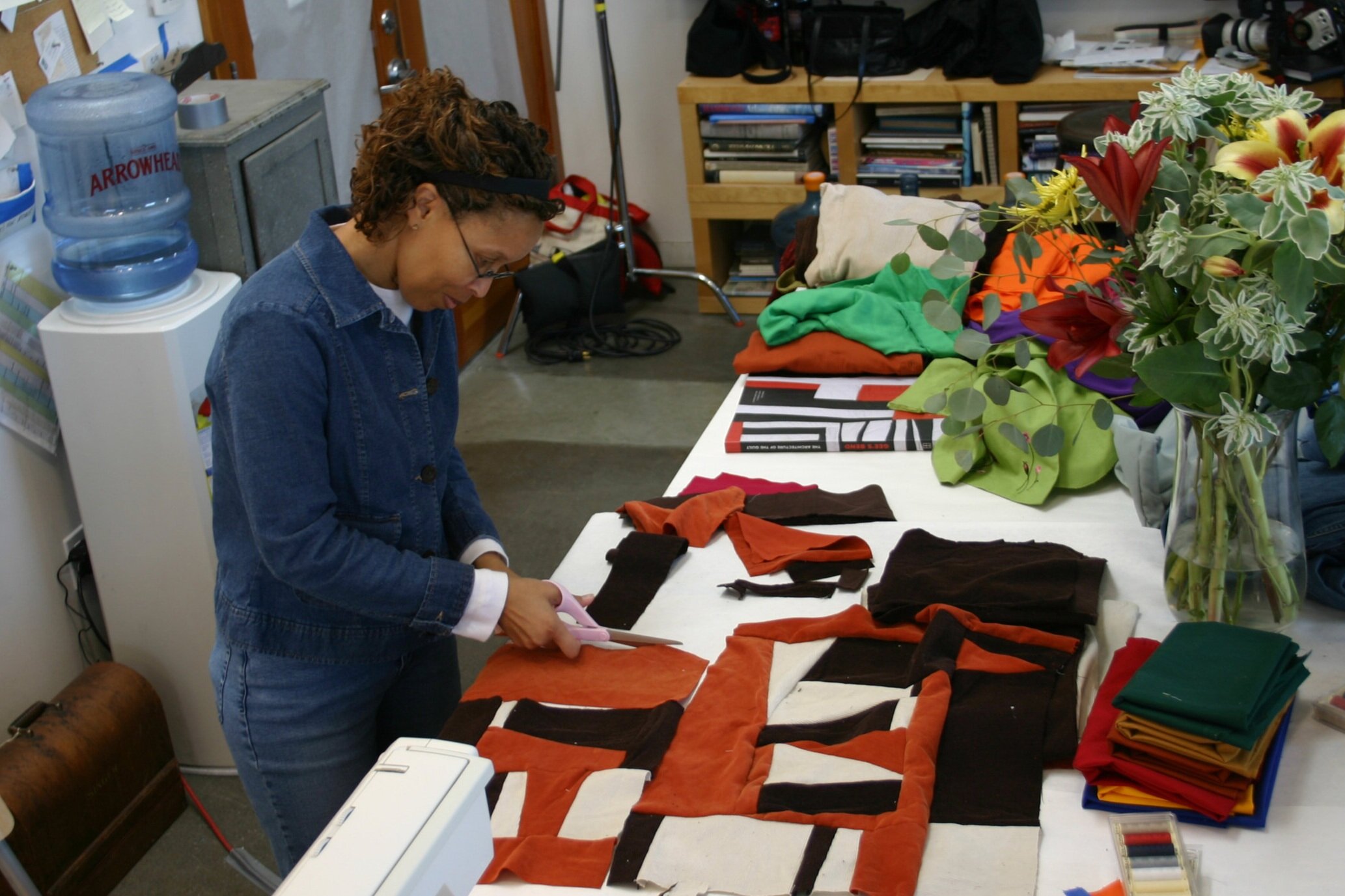In 2006, three quilters from Gee’s Bend, Alabama, came to make prints with Pam Paulson and me in our Berkeley studio. It would be the second time we worked with the women of Gee’s Bend.
Coming from a tiny isolated community in Alabama, Mary Lee Bendolph, Loretta Bennett, and Loretta Pettway knew each other well; their families had been interwoven for generations, and they often worked on each other’s quilts in Gee’s Bend.
In 2004, the quilts had been shown at the Whitney Museum, which launched the women and their art into the high art canon, effectively ushering in a new era of interest in the work of vernacular southern artists. Mary Lee emerged as the matriarch of the quilters. Her easy demeanor and brilliant smile touched many. Mary Lee enjoyed working with old used clothing, which, she explained, contained the “love.” She often punctuated her dark compositions with bright whites or lively salmon pink hues. Her unique compositions made her quilts easily recognizable. In 2006, the U.S. Postal Service issued 10 stamps depicting her quilts. Her customary salutation was a warm hug and dazzling smile. Mary Lee had worked with us in 2005, completing six beautiful prints.
To Honor Mr. Dial, 2005, color aquatint etching, Mary Lee Bendolph.
Loretta Pettway was another senior and venerable quilter. Her work was as well known as Mary Lee’s for her use of old jeans and bold geometric patterns that rivaled the paintings of Sean Scully. Quiet and taciturn, Loretta was harder to read. She kept mostly to herself and spoke so quietly under her breath that I hardly could hear her. While all of the quilters had suffered hardships, hers were tangible. She seldom smiled.
Loretta Bennett was the youngest of the three. She was one of the younger generation of Gee’s Bend quilters. Loretta worked with newer materials, and most of her compositions felt jazzier and more improvisational than those of her elders. All three women were deeply religious.
Loretta Bennett cuts fabric for a quilt top that will be used to make a print, 2006.
The studio was instantly mayhem. We had arranged three sewing machines around the large central studio table. Giant piles of torn-up fabric and haystacks of threads covered every horizontal surface. A team of five printers worked hard to keep up with the work. Mary Lee immediately hit her stride and made several beautiful quilt tops. When a quilt top was finished, the printers would pin the work to the wall. All of us would stand back and admire the individual styles and use of color, composition, and fabric.
It was a group decision picking which quilt tops to turn into prints. Once we decided, the printers would spring into action, cutting copper plates and preparing a soft ground, the first initial step for making the prints. The quilt top was carefully ironed, placed face down on the prepared copper plate, and run through the press. Pressing the quilt into an asphaltum/beeswax layer left an exact impression, recording every seam and fabric texture. After the quilt was removed from the soft ground, the plate was submerged in acid and etched, then cleaned and printed. This completed the first step of making a multiple-plate color intaglio print.
Loretta Pettway spit-bites a plate for her print Bricklayer, 2006.
Passing By, 2007, color aquatint and soft-ground etching, Mary Lee Bendolph.
We worked for two weeks. We completed a total of 11 complicated multiple-plate color prints. It was exhausting and exhilarating. At times, it was difficult to juggle three different artists and personalities. One print from each artist was donated to the Foundation for Art and Preservation in Embassies (FAPE), constituting the first prints by African American artists to be included in the foundation’s program.*
Towards the end of the project, Mary Lee completed a bold composition of red and white. The print was stunning. After pulling a final proof, we all stood admiring the print. “What will you call it?” I asked. She paused for a second and considered. “Passing,” she said solemnly. I knew that a good friend of Mary Lee’s had passed away earlier that month. Her mind was on her friend. I said quietly, “Oh, Mary Lee, you can’t call it Passing...” and she waited a beat and added a word: “Passing By.” Her title pays homage to her friend and acknowledges the shortness of life. It implies that life is the only chance we get to try and improve the world, which Mary Lee has so gracefully done.
It was the novel vision of Bill Arnett and his Souls Grown Deep Foundation, as well as the tireless work by his son Matt Arnett, that laid the groundwork and support for many African American southern artists. The Arnetts were instrumental in bringing about the collaboration between our shop in Berkeley, California, and the women from Gee’s Bend. Without the Arnetts, we would never have learned about the women of Gee’s Bend and their amazing art.
Louisiana Bendolph signs Three Blocks, 2005.
Gee’s Bend quilter Louisiana Bendolph worked with us later that year, completing four prints. One of her prints was also donated to FAPE (Foundation for Art and Preservation in Embassies).
All photos by Renee Bott






